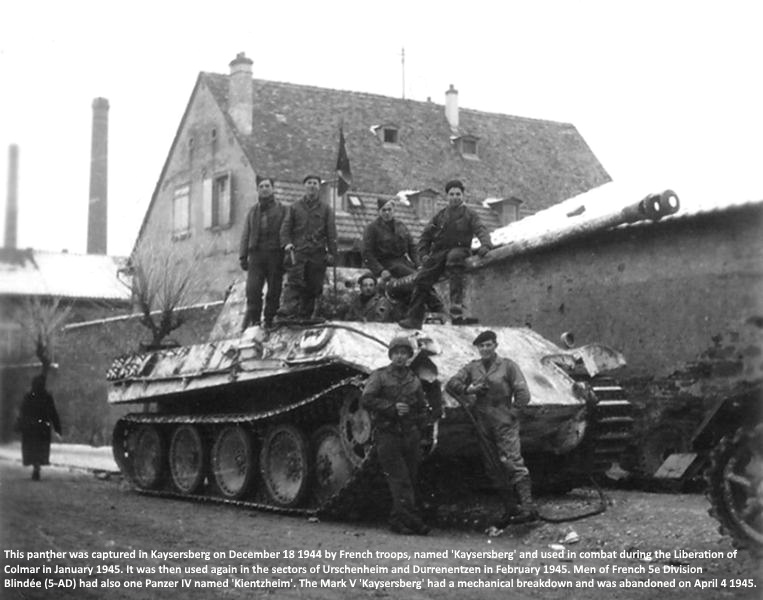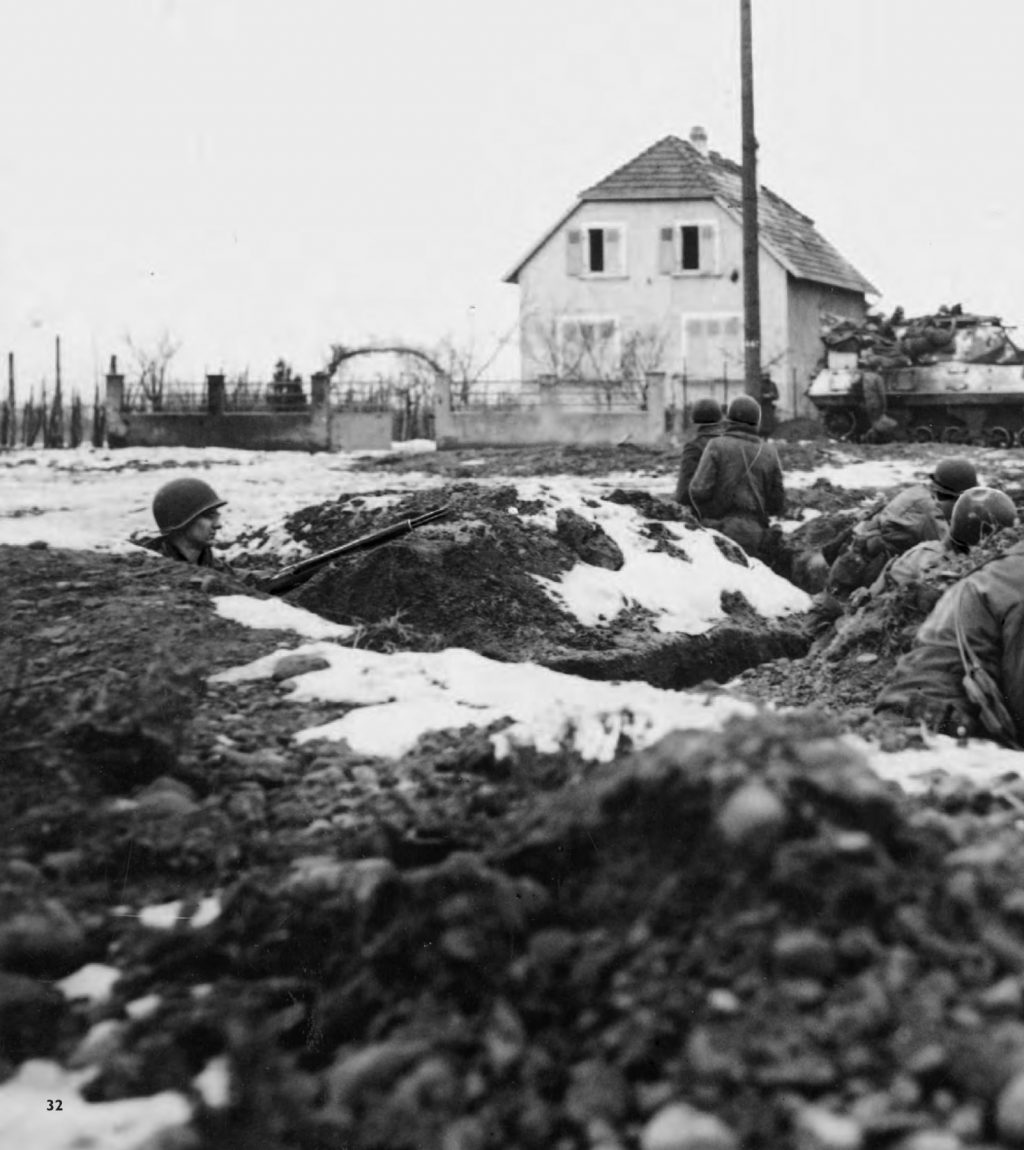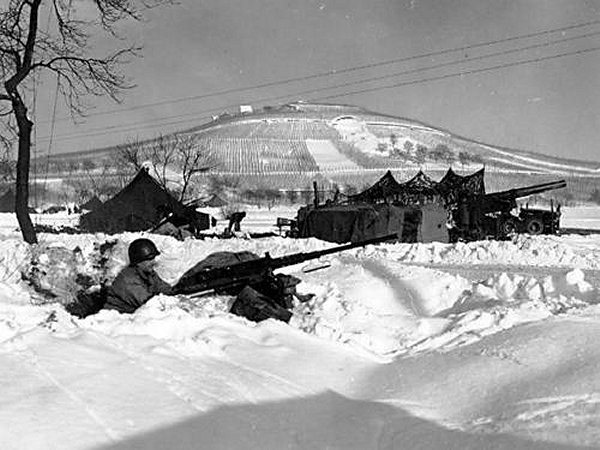7-IR & Easy Co Plan
The broad outline concerning objectives and missions of the 2/7 has already been covered briefly in the consideration of the regimental plan of attack. At the time they were to be briefed on this assault, men of the 2/7 were in billets in the town of Kaysersberg, to which they had moved after being relieved (on Jan 17) of their early January defensive positions high in the snow-laden Vosges Mountains west and south of Ribeauville. These men knew that their stay in Kayserberg was to be short, probably only three or four days and that at the end of this time they would begin a new attack. Their activity, however, showed surprisingly little concern for the future. They busied themselves with other things. All of the men had been quartered in buildings and an attempt was made for rest and comfort and rehabilitation. Gas-protective capes had been sacrificed for window panes in the bomb and shell-torn structures; fires were started where possible in salvaged stoves, security guards were limited to a single sentinel in each platoon or billet and the rest of the men were encouraged to sleep. Company kitchens were brought up and the men were fed three hot meals a day, meals which honest-to-God cooks had cooked, with the result that nine men out of every ten acquired a case of bellyache and the runs, and had to make hurried trips to the battalion aid station for a strong dose of paregoric, a dose which proved an effective and immediate cure in most cases.
So that all these home-comforts would not stale the men for the work which everyone knew lay ahead of them, a limited training and conditioning program was undertaken during this period. Piles of men plodded westward from the town every morning and noon, to muscle-loosening hikes along with the snow and ice-covered roads or to small-scale maneuvers and fire-fights on the vineyard-stepped hills outside the village. The 3rd Plat of Easy Co has engaged in some such programs also. It was billeted on the second floor of a large building that had suffered only slight damage in the battles which had torn and scarred and burned a large proportion of the neighborhood. Its non-commissioned officers used up many a bottle of insecticide and many a C-ration can of gun oil in smoky attempts at candle-light for their card game of Casino, at which partners were changed frequently enough to keep everyone happy and about even in the won-and-lost columns. Members of the platoon were relaxed; they were satisfied with the warmth and the food and the limited training and the long nights of untroubled sleep.
As a platoon, they were mirthful over an incident which concerned themselves and a platoon aid-man who had earned for himself a considerable reputation for fearlessness, a hard-won reputation incidentally, to which the man added in subsequent actions. The entire platoon, except for one guard, was sound asleep the second night of their stay in Kaysersberg when one of the enemy shells which usually plumped hollowly into far neighborhoods in search of a 4.2 chemical mortar unit, pounded instead to an ear-splitting detonation just outside the platoon quarters. All the gas-cape window-panes were blown in and shrapnel tore chunks out of the ceilings of all rooms facing that one side of the building. In the darkness and confusion which followed, high above the hub-bub rang out one voice, beginning in the vicinity of the aid-man’s bunk on the floor and moving miraculously but into the dark hall and down the mysterious black well of the stairs, from which the last syllables floated up to the second floor: the aid station will be in the basement. That no man needed the services thus offered merely made the incident more lasting as a bit of anecdote and folk history of the platoon, capable of drawing a laugh months later.
The afternoon and evening of Jan 21, brought the thing for which everyone was waiting. All of the officers and non-commissioned officers were called to the company CP and oriented as a body on the coming attack. Following this meeting, the platoon leaders alone remained behind to receive maps and a detailed company plan. In his orientation to the larger group, Capt James F. Powell, commanding the Company, outlined these points concerning the battalion plan of attack:
(1) the battalion, when it crossed the Fecht River at Guémar and swung south to take up its position between the 1/7 and the 3/7 would attack in a column of companies; (2) Easy Co would be the leading company in this formation; (3) Easy Co would be the assault company as far as the southeastern tip of the Rothleible Woods, where it would hold up and dig in until other elements of the battalion attacked and reduced the Château de Schoppenwihr; (4) upon the capture of the Château, Easy Co would launch an attack against Rosenkranz, possibly in coordination with another company from the Château area and (5) Easy Co would continue the assault to the final battalion objectives south and southwest of Rosenkranz.
 At the meeting of platoon leaders. Capt Powell led them in a detailed map study since no actual physical recon of the terrain was possible. It was agreed that little could be told concerning the density of the Colmar Forest and of the Rothleible Woods or of the obstacles, German-made or natural, which would be encountered. Capt Powell ordered that initially, upon entrance of the Colmar Forest, the 3rd and the 2nd Plats attack abreast, each with two squads forward. If possible, this formation would be maintained as far as the final objective.
At the meeting of platoon leaders. Capt Powell led them in a detailed map study since no actual physical recon of the terrain was possible. It was agreed that little could be told concerning the density of the Colmar Forest and of the Rothleible Woods or of the obstacles, German-made or natural, which would be encountered. Capt Powell ordered that initially, upon entrance of the Colmar Forest, the 3rd and the 2nd Plats attack abreast, each with two squads forward. If possible, this formation would be maintained as far as the final objective.
The 3rd Plat was assigned the left half of the sector of advance. To it was attached the company section of light machine guns, with orders that these guns were to be carried well forward and in a spot to cover best the left flank of the company when it became engaged with the enemy. The platoon was to guide on the 2nd Plat, which would be on its right. Upon reaching the southeastern edge of the Rothleible Woods, the 3rd Plat was to maintain the defense of the company’s left flank and left front, tying in with the 2nd Plat, which would be in a position to its right and right rear, and with the 1st Plat, which would set up a rear defense in the company area. In addition, the 3rd Plat at this time was to send a strong patrol southwest into Rosenkranz.
When the Château de Schoppenwihr fell and the company received the battalion order to continue the attack, the 3rd, and the 2nd Plats, still attacking abreast, were to take Rosenkranz definite sectors of which were allotted to each platoon. Once Rosenkranz was secure, the same two platoons were to advance to the last two objectives southwest of Rosenkranz’s important road junctions. Besides taking its part information of a strong roadblock with the rest of the company on the second of these last objectives, the 3rd Plat again was to send out a strong patrol – this time south along the main road into Colmar city as far as the patrol could go, with the mission of observing any enemy activity either outside the city or inside the city itself, if the patrol were fortunate enough to get that far. In addition to the section of light machine-guns, the 3rd Plat was given control of its 2’36 rocket launcher team, which at this time normally was under the control of the CO of Easy Co. Since the attack was to be made initially without any armor support, Capt Powell ordered that a full load of rockets be carried and that the rocket launcher teams be charged with AT protection of the platoons and of the company.



















